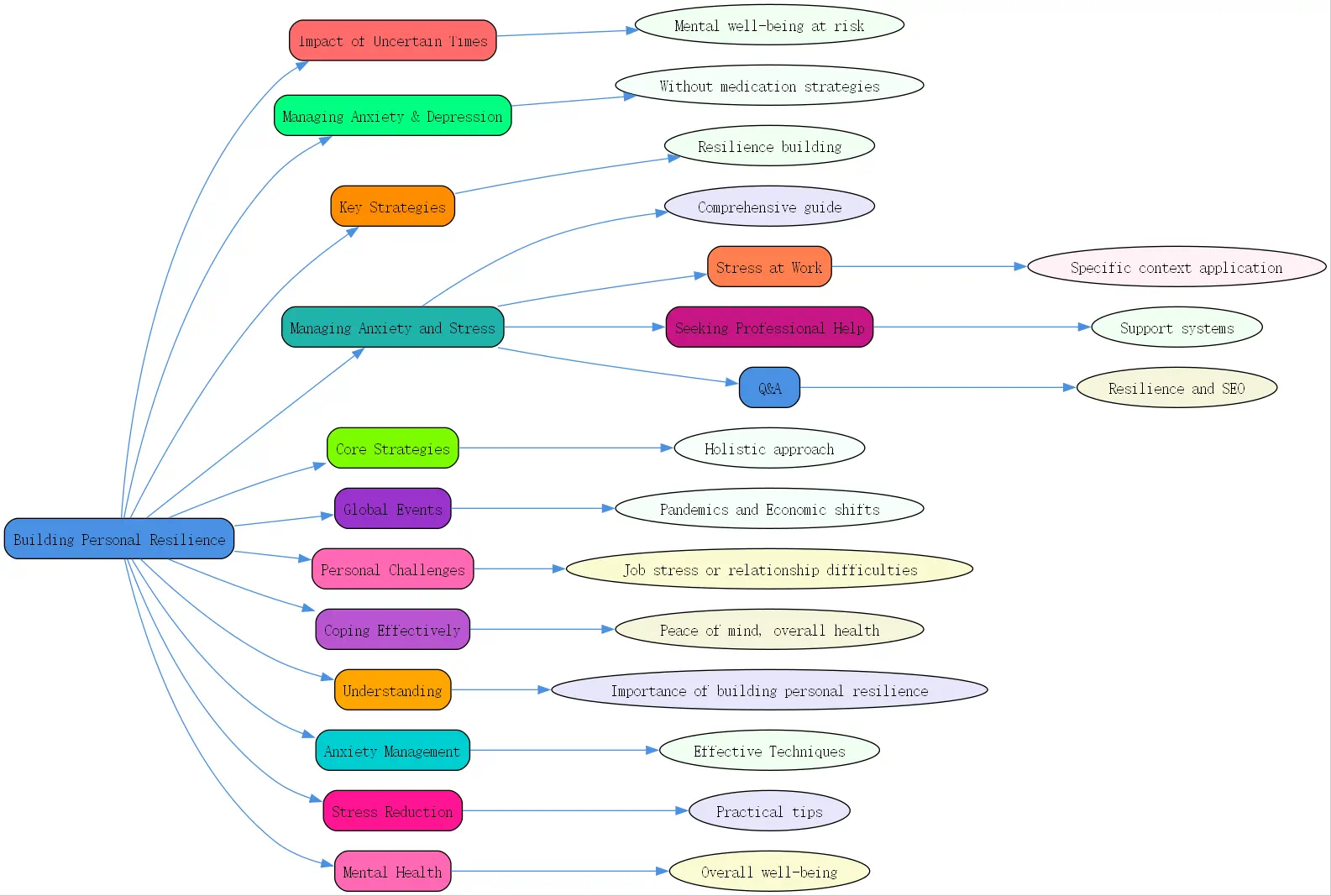Building Personal Resilience: Managing Anxiety and Mental Health During Uncertain Times

Life inevitably throws curveballs. From global events like pandemics and economic shifts to personal challenges like job stress or relationship difficulties, navigating uncertainty is a constant. These periods can significantly impact our mental well-being, often inducing stress and anxiety. Understanding how to cope effectively is crucial not just for our peace of mind, but for our overall health. Here at BrainTalking, we understand the importance of building personal resilience managing anxiety and mental health.
Understanding the Impact of Current Events on Mental Well-being

Events like the recent global pandemic highlighted how external circumstances can act as powerful stress and anxiety inducers. The fear of the unknown, concerns about health, economic instability, and social isolation combined to create a perfect storm for mental distress. It’s a natural human response to feel worried or stressed during such times, but chronic stress takes a significant toll.
Crucially, prolonged stress isn’t just a mental burden; it directly impacts physical health. When we’re stressed, our bodies release hormones like cortisol and adrenaline. While helpful in short bursts, chronic elevation of these hormones can weaken the immune system. Ironically, stressing excessively about health threats could make you more vulnerable to illnesses, creating a vicious cycle. This underscores why proactive stress management is not a luxury, but a necessity for maintaining health.
Therefore, learning and implementing effective stress management techniques becomes paramount, especially during periods of heightened uncertainty. These strategies aren’t about eliminating stress entirely 閳?an impossible goal 閳?but about developing the capacity to navigate it healthily. They equip us with the tools needed to maintain equilibrium, protect our immune function, and foster mental fortitude when we need it most.
5 Key Strategies for Managing Anxiety and Depression Without Medication
While medication has its place in treating anxiety and depression, many effective strategies can be employed to manage symptoms and build resilience naturally. These techniques focus on lifestyle adjustments, mindset shifts, and behavioural changes that empower individuals to take control of their mental well-being. They are fundamental tips to manage anxiety and stress.
Social Innings: Virtual Social Interaction
Humans are inherently social creatures. Connection combats stress, eases anxiety, and lifts depressive moods. However, circumstances like pandemics or even busy modern lives can lead to social isolation or distancing, creating barriers to this vital interaction. While traditional “”social outings”” might be restricted or difficult, the concept of “”social innings”” offers a powerful alternative.
Arrange virtual video chats with friends, family, or colleagues using platforms like Zoom, FaceTime, or Google Duo. Schedule these interactions like you would an in-person meetup 閳?set a time, a date, and perhaps even a theme (like a virtual happy hour or coffee break). Replicating the experience of connection, even virtually, provides significant stress relief and helps maintain those crucial social bonds.
During these virtual gatherings, aim to recreate the activities you’d normally enjoy together. Share a meal, have a drink, discuss hobbies, laugh, or simply offer a listening ear. This deliberate effort to connect provides valuable adult interaction and reminds us that even when physically apart, meaningful relationships can be nurtured. This is a practical approach for managing anxiety and depression without medication.
Make a Schedule: Establishing a Routine
Lack of structure can exacerbate feelings of anxiety and overwhelm. When days blend, especially during periods of disruption like working from home or unemployment, it’s easy to fall into patterns that negatively impact mental health. Neglecting personal hygiene or staying in pajamas all day might seem harmless, but it can contribute to feelings of lethargy and purposelessness, further fueling stress.
Establishing a daily routine is a cornerstone of managing anxiety and mental health. Create a schedule that includes consistent wake-up and bedtimes, designated periods for meals, exercise, work or chores, and, importantly, social interaction (even virtual “”innings””). This structure provides a sense of predictability and control in uncertain times, anchoring your day and reducing mental load.
A schedule doesn’t need to be rigidly enforced down to the minute, but having a basic outline prevents detrimental habits like sleep deprivation. Poor sleep disrupts the body’s natural rhythms, leading to increased stress hormones (adrenaline, cortisol), weakened immunity, and a cascade of other health issues. A simple, flexible routine helps regulate your sleep/wake cycle, boosting both mood and resilience.
Exercise: A Natural Stress Reliever
Physical activity is one of the most potent natural stress relievers available. When you exercise, your body actively works against the physiological effects of stress. It reduces levels of stress hormones like adrenaline and cortisol. Simultaneously, exercise stimulates the production of endorphins 閳?neurotransmitters that act as natural painkillers and mood elevators.
You don’t need to run a marathon to reap the benefits. Any form of movement can help manage stress. Go for a brisk walk or jog, practice yoga or stretching, dance around your living room, or try kickboxing. Find activities you genuinely enjoy, as this increases the likelihood you’ll stick with them. Consistency is key for long-term stress management and overall well-being.
Even finding small pockets of time for activity makes a difference. Studies show that as little as five minutes of cardiovascular exercise can have stress-reducing effects. Integrate movement into your daily routine 閳?take the stairs, walk during phone calls, or do short bursts of activity during breaks. Exercise is not just about physical health; it’s a powerful tool for building personal resilience managing anxiety and mental health.
Control What You Can Control: Limiting Exposure to Negative Information
Feeling overwhelmed by global crises, economic news, or social media feeds is common. Constantly inundating yourself with information about events you cannot personally influence 閳?like global pandemic statistics, stock market fluctuations, or political turmoil 閳?inevitably leads to heightened stress and anxiety. It’s easy to get caught in a cycle of worry about worst-case scenarios.
A crucial strategy is to consciously control what you expose yourself to. Limit your consumption of news and social media, especially sources prone to sensationalism. While staying informed is important, check reputable news sources only once or twice a day for essential updates. Avoid endlessly scrolling or searching for negative information, as search engines are designed to give you what you look for, potentially magnifying unlikely worst-case outcomes.
Instead, shift your focus to aspects of your life you can control. You can control your adherence to health guidelines (like handwashing or distancing when necessary). You can control your daily schedule, your exercise routine, your diet, and how you spend your time (e.g., cleaning, pursuing hobbies). Focusing on actionable steps within your sphere of influence provides a sense of agency and significantly reduces feelings of helplessness and stress. This is vital for managing stress and anxiety at work and home.
Note: If you have a diagnosed anxiety disorder, such as Obsessive-Compulsive Disorder (OCD), simply “”controlling your thoughts”” is more complex. It’s essential to work with your mental healthcare provider on tailored strategies.
Positive Self-Reflections: Cultivating Gratitude
Our internal dialogue significantly shapes our emotional state. Focusing solely on problems or shortcomings can amplify stress and negative feelings. Actively cultivating a practice of positive self-reflection can counteract this tendency and foster a more resilient mindset. It helps shift focus from perceived failures to actual accomplishments and positive experiences.
At the end of each day, take a few moments to look in the mirror or sit quietly and reflect on everything that went well. Acknowledge what you did right, tasks you completed, positive interactions you had, or challenges you navigated successfully. This simple practice helps manage stress by reinforcing your capabilities and promoting a more balanced perspective on your day.
Complement this with keeping a gratitude journal. Regularly writing down things you are thankful for 閳?big or small 閳?helps keep challenges in perspective. Be grateful for your home, access to food and water, supportive loved ones, or even small joys like a sunny day. This practice might seem simple, but it actively counters feelings of frustration or self-pity, reduces stress hormones, and fosters a more positive outlook.
Tips to Manage Anxiety and Stress: A Comprehensive Guide
Beyond the core strategies, understanding how to apply these principles in specific contexts, like the workplace, and knowing when to seek further help are crucial components of managing mental well-being effectively. These additional tips to manage anxiety and stress provide a more holistic approach.

Managing Stress and Anxiety at Work
The workplace, whether remote or in-person, is often a significant source of stress. Deadlines, interpersonal dynamics, workload, and performance pressures can all contribute to anxiety. Applying resilience-building strategies within this context is essential for maintaining productivity and well-being. Adapting the principles discussed earlier offers practical solutions.
Integrate routine into your workday, especially if working from home. Maintain distinct start and end times, schedule regular breaks, and designate a specific workspace if possible. This structure helps create boundaries between work and personal life, preventing burnout. Use breaks strategically 閳?perhaps scheduling short virtual “”social innings”” with colleagues to maintain connection and combat isolation, a common issue in remote settings.
Consciously limit exposure to stressful news or excessive social media during work hours. Constant negative input can fragment focus and heighten anxiety, impacting performance. Instead, focus on controllable tasks and celebrate small wins throughout the day. Implementing these tactics fosters a calmer, more focused work environment, directly aiding in managing stress and anxiety at work.

Seeking Professional Help and Support Systems
While self-help strategies are powerful, it’s vital to recognize when professional support is necessary. If anxiety or depression symptoms are persistent, severe, or significantly interfering with daily life, functioning, or relationships, seeking help from a qualified mental health professional is crucial. These experts can provide accurate diagnoses, evidence-based therapies (like CBT or DBT), and tailored coping mechanisms.
For individuals already diagnosed with a mental health condition, consistency in care is paramount, especially during stressful times. Continue taking any prescribed medications as directed by your doctor and maintain regular appointments with your therapist or psychiatrist. These professionals can help adjust treatment plans as needed to navigate challenging periods effectively. Don’t hesitate to reach out if you feel your symptoms worsening.
Utilize available support systems. Many organizations and communities offer mental health hotlines, online support groups, and resources, particularly during widespread crises. These can provide immediate support and connect you with others facing similar challenges. Remember, seeking help is a sign of strength, not weakness, and is a critical step in effectively managing anxiety and mental health. [Explore BrainTalking’s resources on finding the right therapist].
Key Takeaways for Building Resilience:
- Stay Connected: Prioritize social interaction, using virtual “”innings”” when face-to-face isn’t possible.
- Create Structure: Establish a daily routine for predictability and control.
- Move Your Body: Engage in regular exercise to naturally reduce stress hormones and boost mood.
- Focus on Control: Limit exposure to overwhelming news and concentrate on actions within your power.
- Practice Gratitude: Use positive self-reflection and keep a gratitude journal to maintain perspective.
- Know When to Seek Help: Don’t hesitate to reach out to mental health professionals or utilize support systems.
Q&A: Understanding Resilience and SEO
Q: How does creating content about managing daily stress help BrainTalking’s SEO and build long-term mental resilience awareness?
A: Creating comprehensive, actionable content about managing daily stress directly addresses high-intent search queries like “”tips to manage anxiety and stress“” and “”managing anxiety and depression without medication.”” By providing valuable, expert-backed information (demonstrating E-E-A-T), BrainTalking positions itself as a trustworthy authority in the mental health space. This attracts organic traffic from users actively seeking solutions.
From an SEO perspective, this content targets relevant keywords, improves website authority through quality information and potential backlinks, and increases user engagement (time on page, lower bounce rate). Furthermore, by explaining how these daily practices contribute to building personal resilience managing anxiety and mental health over the long term, the content educates users, fosters trust, and encourages them to explore further resources, potentially including BrainTalking’s services or other articles, enhancing internal linking and overall site value. It aligns user needs with valuable content, fulfilling search intent and boosting SEO performance simultaneously.




